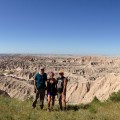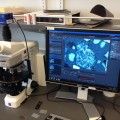NSU Newsroom
SharkBytes
Horizons
This version of NSU News has been archived as of February 28, 2019. To search through archived articles, visit nova.edu/search. To access the new version of NSU News, visit news.nova.edu.
This version of SharkBytes has been archived as of February 28, 2019. To search through archived articles, visit nova.edu/search. To access the new version of SharkBytes, visit sharkbytes.nova.edu.
Halmos College Faculty, Students Study Climate Change During Badlands Expedition

NSU marine biology major Victoria Pecci (second from left) and students from Slippery Rock University participated in the Badlands expedition with Paul Baldauf, Ph.D., professor at NSU’s Halmos College of Natural Sciences and Oceanography, and Patrick Burkhart, Ph.D., professor at Slippery Rock University.
Paul Baldauf, Ph.D., professor at NSU’s Halmos College of Natural Sciences and Oceanography, continues to study climate change across the Great Plains with new field research conducted this summer at the Badlands and Buffalo Gap National Grassland.
NSU marine biology major Victoria Pecci assisted Baldauf in the expedition in southwestern South Dakota. They were joined by Patrick Burkhart, Ph.D., professor, and two students from Slippery Rock University in Pennsylvania. NSU undergraduate students Silke Dunn and Won “Jenny” Jaegal are helping Baldauf with follow-up analysis at NSU’s Oceanographic Center.
“The research mission of the trip to the Badlands was to investigate climate change on the Great Plains in the Quaternary, or roughly the last two million years of earth history,” Baldauf said. “We are focused on drought events that occurred in the most recent Quaternary. There is some fear that climate change might dry out the central section of the U.S.
“The Sand Hills of Nebraska are a huge field of sand dunes that are periodically transformed into an enormous desert. Our field area is just north of–and probably related to–the dunes in the Sand Hills. Our area has not been studied because of its remoteness and harsh climate. We are collecting samples from the dunes for analysis using a technique called optically stimulated luminescence (OSL).”
By determining when the sand dunes were last active, Baldauf hopes the research will pinpoint the most recent prehistoric mega-drought in the northern Great Plains.
“Using OSL, you can tell time since the most recent exposure of the sediment to sunlight,” Baldauf said.
“The most recent exposure was the last time it was so dry that the dunes were blowing across the prairie. There is no written record of when that happened, but it may have been recent enough to affect the indigenous people of the area.”
Pecci traveled to South Dakota with her family and joined Baldauf in the field research.
“I don’t know much about geology so it was a great way to learn hands-on about sediment and how rocks are formed,” Pecci said. “I had never been to South Dakota or the Badlands. I loved getting some research/field experience while enjoying my time there.
“I learned a lot about geology and how rocks can tell us about aging and give us insight into what the world was like. I hope to use what I learned to incorporate it into my marine biology studies,” she said.
Paul R. Hanson, Ph.D., associate director at the School of Natural Resources at the University of Nebraska-Lincoln, is conducting the OSL analyses.
Baldauf continues the collaborative work at the geology and coral reef systems laboratory at NSU’s Oceanographic Center. There, he and students are using a petrographic microscope to conduct analysis and study the texture and composition of the sand, “which may help us determine where that sand came from and what the climate conditions were like when the sand blew in. The source of the sand for our dunes and the dunes in the Sand Hills is still something of a mystery.
“We analyzed five samples from one dune field last year and we sampled two more dune fields this year, most of them on private land in the Buffalo Gap National Grassland, which is south of the Badlands National Park,” he said. “If we can sample three or four fields of dunes and get good ages, we should be able to tell the last time there was a drought strong enough to destroy vegetation that holds the sand in place. We think this would take a drought stronger than anything witnessed by residents in the last 500 years.”
- At a remote section of the Badlands called the Stronghold Unit: marine biology major Victoria Pecci; Paul Baldauf, Ph.D., professor at NSU’s Halmos College of Natural Sciences and Oceanography; and Patrick Burkhart, Ph.D., professor at Slippery Rock University, Pennsylvania.
- The petrographic microscope at NSU’s Oceanographic Campus is being used for analysis by Paul Baldauf, Ph.D., professor at Halmos College of Natural Sciences and Oceanography, and NSU undergraduate students Silke Dunn and Won “Jenny” Jaegal.
- NSU marine biology major Victoria Pecci uses a bucket auger to get a sample of sand from an inactive sand dune in the Badlands in southwestern South Dakota.


